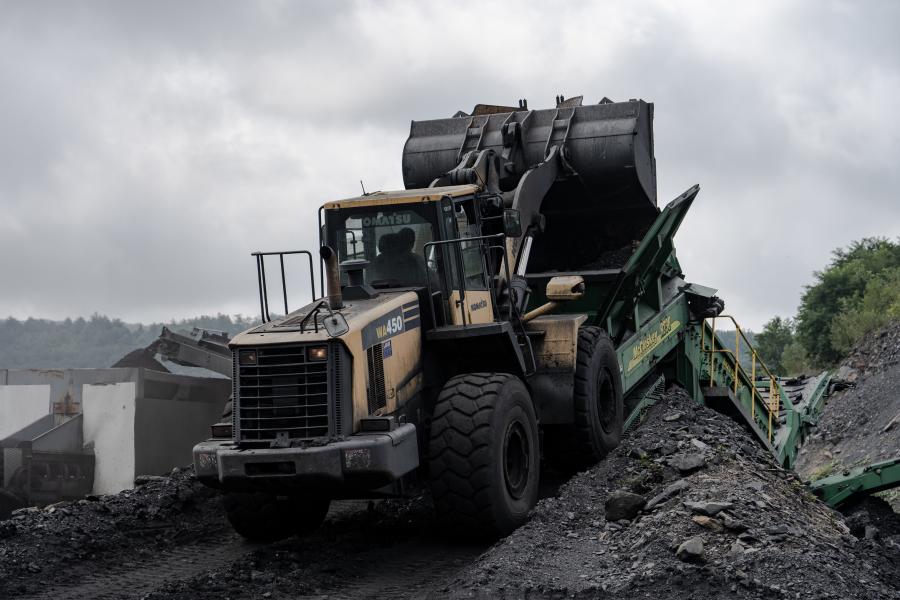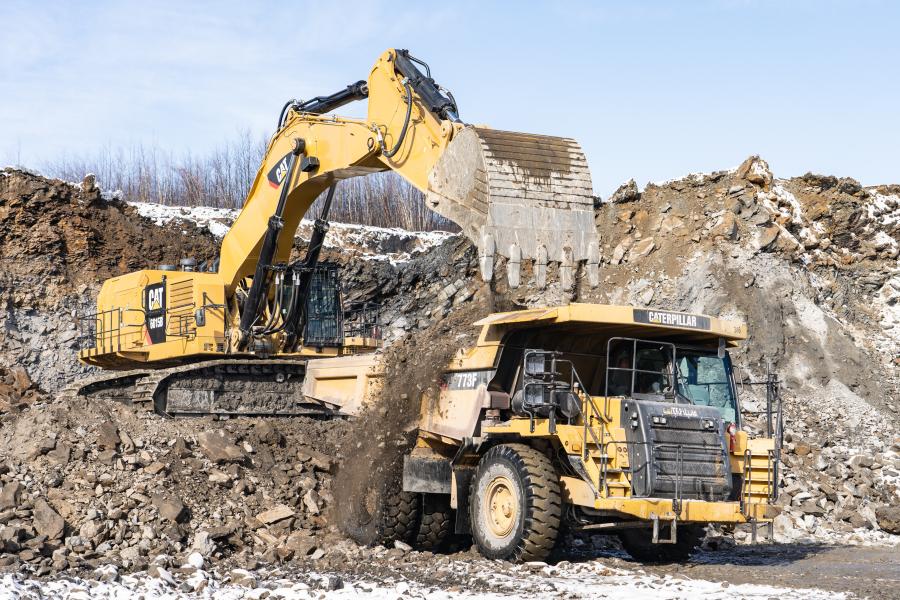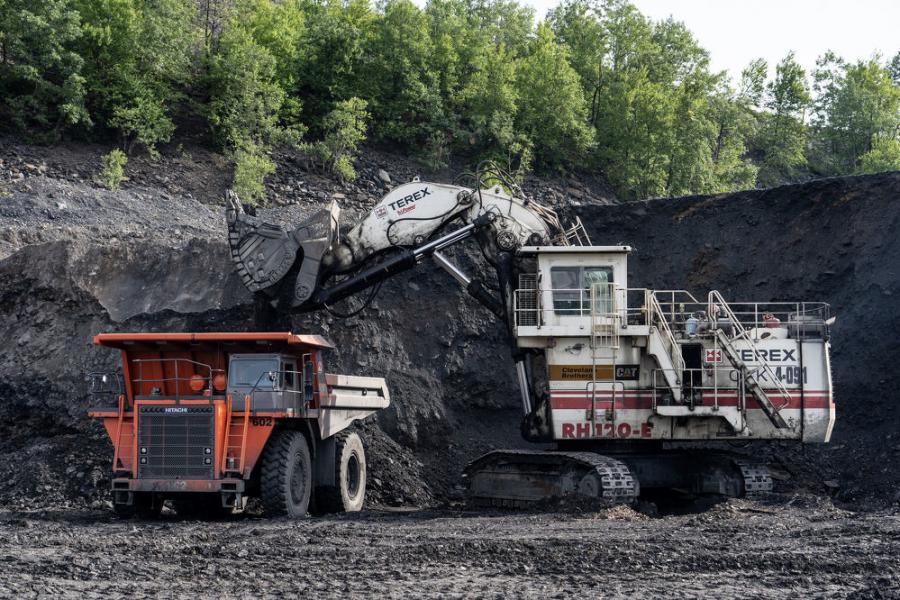A Terex O&K RH120E loads overburden into a Hitachi EH1700-3 rigid frame truck.
(Editor's note: this is the first of a multi-part series that explores Lehigh Anthracite Coal LLC's operations in Pennsylvania, the equipment it uses in its successful mining business and more. Click here to read part 2. Click here to read part 3)
Anthracite mining in Pennsylvania has a long and rich history dating back to the 1700s. In the early days and up to the 1970s, deep mining was how anthracite coal was extracted from the land on which Lehigh Anthracite Coal LLC operates.
Lehigh Anthracite Coal LLC operates an open pit mine on approximately 8,000 acres of land just outside of Tamaqua, Pa., in Schuylkill County. Lehigh Anthracite is the contract miner, employer and maintainer of all building assets on the property. There are 100 employees currently employed by the company. Lehigh Anthracite LP, a partnership between BET Associates IV LLC, and Robindale Energy & Associated Companies, owns all equipment on the property. BET Associates IV LLC is the mineral and land owner. BET Associates IV LLC's members are Bruce Toll and Douglas Topkis. Lehigh Anthracite currently operates two mine sites, which are Job 88 and Little Italy. Job 88 is closer to Tamaqua while Little Italy is closer to Nesquehoning, Pa.
Anthracite coal was first found in this particular area back in the 1790s. A man named Philip Ginter initiated the purchase of a section of 8,000 acres of land between Tamaqua and Jim Thorpe for the Lehigh Coal Mine Company. Lehigh Coal Mine Company could not efficiently mine and transport the coal, so the work was then leased to and eventually purchased by Lehigh Coal & Navigation Company (LC&N), owned by Josiah White. (Lehigh Coal & Navigation Co. included navigation in their name because they shipped their product via barge.) The coal was shipped via barge from Jim Thorpe to Allentown, Pa., and Philadelphia. Coal was mined on this plot of land by Lehigh Coal & Navigation Company from 1822 until 1967.

In 1967, the Fazio Brothers took possession of the property. In 1974, Bethlehem Steel bought the property and sold it in 1989 to James Curran. James Curran reestablished the Lehigh Coal and Navigation (LCAN) brand shortly after the land purchase. In 2008, due to financial issues within the company and the global recession, LCAN folded shortly after going bankrupt.
Bruce Toll and Doug Topkis (the members of BET Associates IV LLC), who had already invested some money into LCAN, decided to purchase the LCAN assets (and liabilities). The assets included the 8,000-acre plot of land, the Greenwood Breaker, mining equipment and a handful of employees. Toll and Topkis had no experience in the mining industry, so they turned to Robindale Energy & Associated Companies and Lehigh Anthracite was born. In 2011, the mining permit was transferred and mining, cleanup and reclamation have been in full swing ever since.
Richard "Rusty" Taylor is the CEO of Lehigh Anthracite Coal LLC. Taylor is the former vice president of Environmental and Regulatory Matters at Robindale Energy & Associated Companies. He is a graduate of Penn State University with a degree in Forestry. After graduating from Penn State in the 1970s, Taylor submitted his application to the U.S. Forestry Service but did not get the job. Taylor then turned to a local coal mine and was hired as a off-road dump truck operator. He has been involved in the coal industry ever since his days as the haul truck driver.
Why Anthracite?
Anthracite coal is the cleanest burning coal. The reason for this is the extremely high carbon content compared to other coal. The coal coming out of Lehigh Anthracite Coal's mines are between 84 percent and 88 percent carbon content with very low ash and volatility content. These factors make anthracite coal ideal for uses in many different applications. Lehigh's coal is used in steel making, carbon injections, charge carbons, water filtration, power generation, heating and cooking ovens.

Lehigh Anthracite processes all its coal on the property. Once the overburden is removed and dumped back into an already mined portion of the site, the raw coal is excavated and placed into haul trucks. On the Little Italy site, the extracted coal is dumped in a collection area by the haul trucks. Because the site is inaccessible by haul truck, the coal is then placed into on-road dump trucks and taken to the processing plant. On the Job 88 site, the coal is taken to the processing plant by the haul trucks.
All raw coal is placed into a crusher where it is crushed to a uniform size before entering the plant. Lehigh does its best to separate any pieces of wood (from previous underground mines) and other contaminants from the raw coal. Approximately 50 percent of raw coal is actually useable after being processed.
This coal makes its way into rail cars, on road trucks and bags. Lehigh Anthracite's coal is shipped worldwide to many customers. Lehigh Anthracite offers a wide range of products for nearly any possible need and its coal is highly sought after by national and international companies.
Supplying the Coal Needs of the World
Lehigh Anthracite Coal produces a wide array of coal products from its mines in Tamaqua and Nesquehoning, Pa. These finished products include:
- Egg/Stove, which is 3 ¼-in. x 1 9/16 in. This is used as a carbon additive in electric arc furnaces (EAF), as well as a heat source in the sugar beet process, and as a radiant heat source in pizza ovens;
- Nut, which is 1 9/16-in. x 13/16-in. This also is used in EAFs and is a very popular size for home heating;
- Pea, which is 13/16-in. x 9/16-in. This is another size popular for use in EAFs and sometimes home heating;
- Buck, which is 9/16-in. x 7/16-in. This particular size is ground into a paste that is then made into high voltage electrodes for EAFs. This also is a source of heat for large greenhouses;
- Rice, which is 7/16-in. x 3/16-in. and is very popular for home heating;
- Barley, which is 3/16-in. x 3/32-in. This is used in carbon injection in EAFs to create an insulating blanket on top of the liquid metal in a kettle;
- #4, which is 3/32-in. x 3/64-in. This is used as a filter media (along with sand) in municipal water treatment plants; and
- #5, which is 1 mm x 100 mesh. This also is used in carbon injection for EAF, water filtration and as an ingredient in charcoal briquettes.
CEG
Today's top stories
























